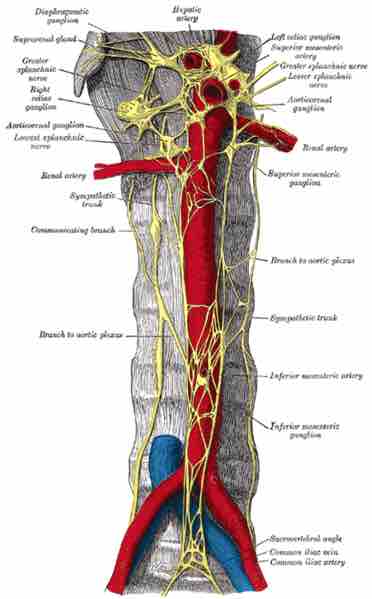Autonomic plexuses are formed from sympathetic postganglionic axons, parasympathetic preganglionic axons, and some visceral sensory axons. The nerves in the each plexus are close to each other, as in the plexuses of the somatic nervous system, but typically do not interact or synpase together.
Instead, they provide a complex innervation pattern to the target organs, since most organs are innervated by both divisions of the autonomic nervous system. The autonomic plexuses include the cardiac plexus, the pulmonary plexus, the esophageal plexus, and abdominal aortic plexus, and the superior and inferior hypogastric plexuses.
Plexuses
Cardiac
The cardiac plexus is a plexus of nerves situated at the base of the heart that innervates the heart. The superficial part of the cardiac plexus lies beneath the arch of the aorta, in front of the right pulmonary artery. It is formed by the superior cardiac branch of the left sympathetic trunk and the lower superior cervical cardiac branch of the left vagus nerve. A small ganglion, the cardiac ganglion of Wrisberg, is occasionally found connected with these nerves at their point of junction.
Pulmonary
The pulmonary plexus is an autonomic plexus formed from pulmonary branches of vagus nerve and the sympathetic trunk. It supplies the bronchial tree and the visceral pleura.
Esophageal
The esophageal plexus is formed by nerve fibers from two sources: the branches of the vagus nerve and the visceral branches of the sympathetic trunk. The esophageal plexus and the cardiac plexus contain the same types of fibers and are both considered thoracic autonomic plexus(es).
Abdominal
The abdominal aortic plexus is formed by branches derived, on either side, from the celiac plexus and ganglia, and receives filaments from some of the lumbar ganglia. It is situated on the sides and front of the aorta, between the origins of the superior and inferior mesenteric arteries.
From this plexus arise parts of the spermatic, the inferior mesenteric, and the hypogastric plexuses; it also distributes filaments to the inferior vena cava.

Sympathetic trunk
This section of the sympathetic trunk shows both the celiac and the hypogastric plexus.
Superior Hypogastric Plexus
The superior hypogastric plexus (in older texts, hypogastric plexus or presacral nerve) is a plexus of nerves situated on the vertebral bodies below the bifurcation of the abdominal aorta.
Inferior Hypogastric Plexus
The inferior hypogastric plexus (pelvic plexus in some texts) is a plexus of nerves that supplies the viscera of the pelvic cavity. The inferior hypogastric plexus is a paired structure, with each situated on the side of the rectum in the male, and at the sides of the rectum and vagina in the female.